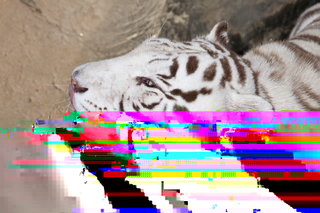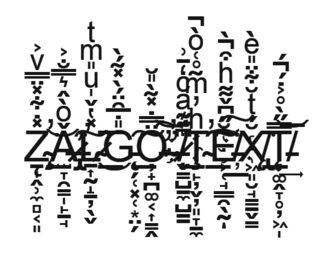
JPEG is a commonly used method of lossy compression for digital images, particularly for those images produced by digital photography. The degree of compression can be adjusted, allowing a selectable tradeoff between storage size and image quality. JPEG typically achieves 10:1 compression with little perceptible loss in image quality. Since its introduction in 1992, JPEG has been the most widely used image compression standard in the world, and the most widely used digital image format, with several billion JPEG images produced every day as of 2015.

In information technology, lossy compression or irreversible compression is the class of data compression methods that uses inexact approximations and partial data discarding to represent the content. These techniques are used to reduce data size for storing, handling, and transmitting content. The different versions of the photo of the cat on this page show how higher degrees of approximation create coarser images as more details are removed. This is opposed to lossless data compression which does not degrade the data. The amount of data reduction possible using lossy compression is much higher than using lossless techniques.

JPEG 2000 (JP2) is an image compression standard and coding system. It was developed from 1997 to 2000 by a Joint Photographic Experts Group committee chaired by Touradj Ebrahimi, with the intention of superseding their original JPEG standard, which is based on a discrete cosine transform (DCT), with a newly designed, wavelet-based method. The standardized filename extension is .jp2 for ISO/IEC 15444-1 conforming files and .jpx for the extended part-2 specifications, published as ISO/IEC 15444-2. The registered MIME types are defined in RFC 3745. For ISO/IEC 15444-1 it is image/jp2.

A compression artifact is a noticeable distortion of media caused by the application of lossy compression. Lossy data compression involves discarding some of the media's data so that it becomes small enough to be stored within the desired disk space or transmitted (streamed) within the available bandwidth. If the compressor cannot store enough data in the compressed version, the result is a loss of quality, or introduction of artifacts. The compression algorithm may not be intelligent enough to discriminate between distortions of little subjective importance and those objectionable to the user.
Glitch is a genre of electronic music that emerged in the 1990s which is distinguished by the deliberate use of glitch-based audio media and other sonic artifacts.

A glitch is a short-lived fault in a system, such as a transient fault that corrects itself, making it difficult to troubleshoot. The term is particularly common in the computing and electronics industries, in circuit bending, as well as among players of video games. More generally, all types of systems including human organizations and nature experience glitches.

Posterization or posterisation of an image is the conversion of a continuous gradation of tone to several regions of fewer tones, causing abrupt changes from one tone to another. This was originally done with photographic processes to create posters. It can now be done photographically or with digital image processing, and may be deliberate or an unintended artifact of color quantization. Posterization is often the first step in vectorization (tracing) of an image.
Glitching is an activity in which a person finds and exploits flaws or glitches in video games to achieve something that was not intended by the game designers. Players who engage in this practice are known as glitchers. Some glitches can be easily achieved, while others are either very difficult or unperformable by humans and can only be achieved with tool-assisted input. Glitches can vary greatly in the level of game manipulation, from setting a flag to writing and executing custom code from within the game.
A container format or metafile is a file format that allows multiple data streams to be embedded into a single file, usually along with metadata for identifying and further detailing those streams. Notable examples of container formats include archive files and formats used for multimedia playback. Among the earliest cross-platform container formats were Distinguished Encoding Rules and the 1985 Interchange File Format.

Digital cinematography is the process of capturing (recording) a motion picture using digital image sensors rather than through film stock. As digital technology has improved in recent years, this practice has become dominant. Since the mid-2010s, most movies across the world are captured as well as distributed digitally.
An image file format is a file format for a digital image. There are many formats that can be used, such as JPEG, PNG, and GIF. Most formats up until 2022 were for storing 2D images, not 3D ones. The data stored in an image file format may be compressed or uncompressed. If the data is compressed, it may be done so using lossy compression or lossless compression. For graphic design applications, vector formats are often used. Some image file formats support transparency.

Michael Betancourt is a critical theorist, film theorist, art & film historian, and animator. His principal published works focus on the critique of digital capitalism, motion graphics, visual music, new media art, theory, and formalist study of motion pictures.

Annie Abrahams is a Dutch performance artist specialising in video installations and internet based performances, often deriving from collective writings and collective interaction. Born and raised in Hilvarenbeek in the Netherlands, she migrated to and settled in France in 1987. Her performance work challenges and questions the limitations and possibilities of online communication and collaboration. Abrahams describes her body of work as "an aesthetics of trust and attention." Studying biology became an inspiration for her future line of work. "When studying biology I had to observe a colony of monkeys in a zoo. I found this very interesting because I learned something about human communities by watching the apes. In a certain way I watch the internet with the same appetite and interest. I consider it to be a universe where I can observe some aspects of human attitudes and behaviour without interfering."

The Nikon D5200 is an F-mount DSLR camera with a newly developed 24.1-megapixel DX-format CMOS image sensor first announced by Nikon on November 6, 2012 for most of the world and January 7, 2013 for the North American market.

"A Glitch Is a Glitch" is the fifteenth episode of the fifth season of the American animated television series Adventure Time. It was written, storyboarded, and directed by Irish filmmaker David OReilly. It originally aired on Cartoon Network on April 1, 2013.

Rosa Menkman is a Dutch art theorist, curator, and visual artist specialising in glitch art and resolution theory. She investigates video compression, feedback, and glitches, using her exploration to generate art works.

Databending is the process of manipulating a media file of a certain format, using software designed to edit files of another format. Distortions in the medium typically occur as a result, and the process is frequently employed in glitch art.
Takeshi Murata is an American contemporary artist who creates digital media artworks using video and computer animation techniques. In 2007 he had a solo exhibition, Black Box: Takeshi Murata, at the Hirshhorn Museum and Sculpture Garden in Washington, D.C. His 2006 work "Pink Dot" is in the Hirshhorn's permanent collection, and his 2005 work "Monster Movie" is in the permanent collection of the Smithsonian American Art Museum. His 2013 short film "OM Rider" was selected to screen as an animated short film at the 2015 Sundance Film Festival.
Richard Castelli is a producer, artistic consultant and curator of numerous exhibitions associated with art, science, performance, or new technologies.

Zalgo text, also known as cursed text due to the nature of its use, is digital text that has been modified with numerous combining characters, Unicode symbols used to add diacritics above or below letters, to appear frightening or glitchy.















